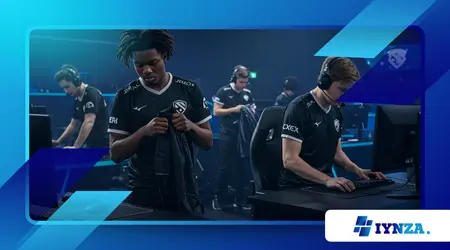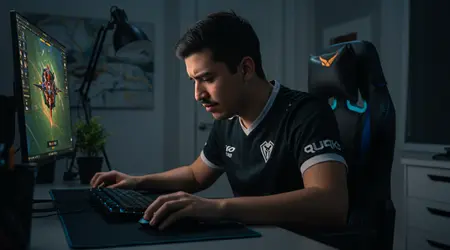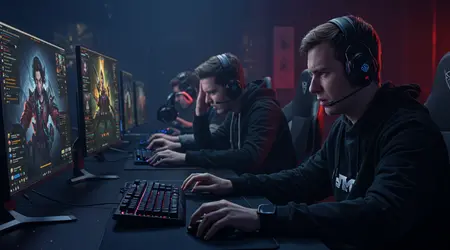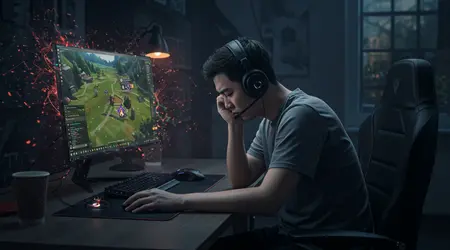Why High Elo Players Quit Ranked – And How to Avoid Burnout Yourself

High elo players quit ranked for reasons that go beyond losing streaks or bad teammates. The grind to the top in competitive gaming whether in League of Legends, Valorant, or Dota 2 demands relentless focus, emotional resilience, and countless hours of practice.
Anúncios
For many elite players, the thrill of climbing ranks transforms into a grueling marathon that tests their mental and physical limits.
A 2023 study by the Entertainment Software Association revealed that 71% of gamers reported experiencing stress from competitive play, with high elo players facing amplified pressure due to their visibility and expectations.
This article dives into why top-tier players abandon ranked queues, exploring the psychological, social, and structural factors at play.
More importantly, it offers practical, actionable strategies to help you sidestep burnout and keep your passion for gaming alive.
Why do some of the best players walk away from the grind? Let’s unpack the reasons and arm you with tools to thrive.
The Pressure Cooker of High Elo
Elite ranks like Diamond, Master, or Radiant aren’t just badges of skill they’re pressure cookers. High elo players quit ranked when the constant demand to perform becomes suffocating.
Every match feels like a high-stakes audition, where a single misplay can tank your reputation. The fear of dropping ranks looms large, creating a cycle of anxiety that erodes enjoyment.
Streamers and pros face added scrutiny, with thousands watching their every move. This relentless spotlight can make even victories feel hollow.
++ Esports Performance Coaches: What They Actually Do (And Do You Need One?)
The mental toll is steep. Players often tie their self-worth to their rank, leading to an identity crisis when performance dips.
For example, “Alex,” a fictional but relatable Diamond Valorant player, spent 12 hours daily grinding to maintain his rank, only to feel trapped by the need to prove himself. The lack of downtime left him drained, questioning why he played at all.
Social dynamics worsen this. High elo communities can be toxic, with teammates quick to flame or blame. This hostility chips away at motivation, pushing players toward less stressful environments like casual modes or other games.

The Grind That Never Ends
Ranked play is a treadmill with no off switch. High elo players quit ranked because the grind feels Sisyphean endless and unrewarding.
Unlike lower ranks, where improvement is tangible, top-tier players hit a skill ceiling where gains are marginal. Hours of practice yield diminishing returns, and the effort to stay competitive feels disproportionate to the reward.
For instance, a League of Legends Challenger player might spend weeks perfecting a single champion’s mechanics only to face a meta shift that renders their efforts obsolete.
The time commitment is brutal. Pros like Faker from T1 reportedly practice 12–16 hours daily, a pace unsustainable for most.
Also read: How to Create a Sustainable Scrim Schedule for Amateur Teams
Even semi-pros struggle to balance gaming with work, school, or relationships. This relentless schedule leaves little room for joy, turning passion into obligation.
Game updates exacerbate this. Patches can upend strategies overnight, forcing players to relearn metas or adapt to new mechanics. The constant need to stay ahead drains mental energy, making burnout almost inevitable.
The Social and Community Disconnect
High elo isn’t just about skill it’s a social arena. High elo players quit ranked when the community feels isolating or hostile. At the top, the player pool shrinks, meaning you face the same opponents repeatedly.
Rivalries can turn personal, and grudges spill into toxic chat or targeted griefing. For example, “Sara,” a fictional Master-tier Apex Legends player, quit after enduring harassment from a rival squad across multiple matches.
Online platforms amplify this. On X, high elo players often face doxxing or public shaming for mistakes, especially if they’re streamers.
Read more: The Rise of Tactical Shooters: Why Every FPS Pro Is Switching Gears
The lack of camaraderie common in lower ranks makes the grind feel lonely. Without a supportive community, players lose the sense of belonging that fuels long-term engagement.
The expectation to always be “on” socially is exhausting. High elo players are often seen as role models, pressured to maintain a positive image while navigating toxic interactions. This disconnect drives many to seek friendlier gaming spaces.
The Professional Dream That Fades

For many, high elo is a stepping stone to pro play. But when the dream stalls, high elo players quit ranked. The path to professional esports is narrow only 0.01% of players reach pro status, per a 2024 Esports Insider report.
The grind to stay relevant often feels futile when tryouts or scouting opportunities don’t materialize. Players like “Jake,” a fictional Radiant Valorant player, spent years chasing pro contracts, only to burn out after repeated rejections.
The financial reality hits hard. Most high elo players aren’t earning a living from gaming, yet the time investment rivals a full-time job.
Without sponsorships or team support, the cost-benefit ratio feels lopsided. Many pivot to content creation, but that path brings its own pressures, like algorithm dependence and audience demands.
The lack of clear progression paths in some games adds to the frustration. Unlike traditional sports, esports often lacks structured pipelines for talent, leaving players feeling stuck in an endless ranked loop.
Burnout: The Silent Killer of Passion
Burnout isn’t just fatigue it’s a soul-crushing loss of purpose. High elo players quit ranked when gaming stops feeling like a game.
Symptoms include irritability, apathy, and physical exhaustion from long sessions. A 2023 Journal of Behavioral Addictions study found that 68% of competitive gamers reported burnout symptoms, with high elo players at higher risk due to intense pressure. The dopamine rush of winning fades, leaving only the grind.
Burnout often creeps in unnoticed. Players push through slumps, mistaking them for temporary dips, until they dread logging in.
The lack of balance neglecting sleep, exercise, or hobbies amplifies this. For example, neglecting meals to queue for one more match can spiral into chronic stress.
The stigma around taking breaks doesn’t help. High elo culture glorifies grinding, making players feel weak for stepping back. This toxic mindset traps them in a cycle where quitting feels like the only escape.
How to Avoid Burnout and Stay in the Game

You don’t have to be another casualty of the ranked grind. Avoiding burnout starts with intentional habits that prioritize your mental and physical health.
First, set boundaries. Limit playtime to 6–8 hours daily, and schedule breaks every 90 minutes. Use tools like Pomodoro timers to enforce this. For example, after three Valorant matches, take 15 minutes to stretch or hydrate.
Second, diversify your gaming. Play casual modes or other genres to refresh your perspective. A Dota 2 player might try Among Us for a low-stakes laugh. This keeps gaming fun without the ranked pressure.
Third, build a support network. Join positive gaming communities on Discord or X, where you can share tips and vent frustrations. A supportive squad can make even tough losses bearable.
Practical Tools to Combat Burnout
Knowledge is power, but action is survival. Use apps like Headspace for mindfulness to manage stress. Track your playtime with tools like RescueTime to avoid overdoing it. Regular exercise 30 minutes daily boosts mood and focus, countering the sedentary grind.
Experiment with goal-setting. Instead of obsessing over rank, focus on micro-goals, like improving your KDA or mastering a new role. This shifts the focus from external validation to personal growth, reducing pressure.
Engage with content creators who promote healthy gaming. Channels like Healthy Gamer GG on YouTube offer practical advice for balancing passion and well-being, helping you stay grounded.
Table: Common Burnout Triggers and Solutions
| Trigger | Impact | Solution |
|---|---|---|
| Endless grinding | Loss of motivation | Set daily playtime limits |
| Toxic community interactions | Emotional exhaustion | Join positive Discord groups |
| Unbalanced matchmaking | Frustration from unfair losses | Take breaks after bad streaks |
| Lack of progression clarity | Feeling stuck in rank | Focus on micro-goals like KDA |
Building Resilience Through Balance
Resilience isn’t about grinding harder it’s about smarter self-care. Prioritize sleep; 7–9 hours nightly sharpens reflexes and decision-making.
Nutrition matters too swap energy drinks for balanced meals to stabilize energy levels. A pro Overwatch player once shared on X how cutting caffeine improved their consistency.
Reflect on why you play. Write down what drew you to ranked mastery, competition, or community and revisit it during slumps. This anchors your motivation beyond fleeting wins.
Connect with mentors or coaches. Platforms like GamerSensei offer personalized guidance to refine skills without burning out, helping you stay focused and inspired.
The Role of Game Design in Burnout
Game design itself can fuel burnout. High elo players quit ranked when systems incentivize endless grinding over enjoyment.
Matchmaking algorithms, for instance, often pair players unevenly, leading to frustrating losses. Games like League of Legends have faced criticism for slow rank progression, making climbs feel futile.
Developers could ease this by rewarding consistency over volume, like bonus LP for win streaks.
Seasonal resets are another culprit. Resetting ranks every few months forces players to regrind, erasing hard-earned progress. This discourages long-term engagement, especially for those balancing real-world responsibilities.
Community feedback loops matter. Games with active developer communication like Valorant’s patch notes or X AMAs build trust, reducing player frustration. Developers should prioritize transparent updates to keep high elo players invested.
Conclusion: Reclaim Your Love for the Game
The ranked ladder can feel like a tightrope, but it doesn’t have to break you. High elo players quit ranked when the grind overshadows the joy, but you can rewrite that story.
By setting boundaries, diversifying your gaming, and prioritizing self-care, you can sustain your passion without sacrificing your well-being.
The 68% of gamers reporting burnout symptoms don’t have to include you. Reflect on why you started, lean on supportive communities, and embrace balance.
Gaming is a marathon, not a sprint pace yourself to stay in the game. What will you do today to keep the spark alive?
Frequently Asked Questions
Why do high elo players feel more burnout than casual players?
High elo players face intense pressure to maintain rank and reputation, amplifying stress. Casual players enjoy more flexibility, with less at stake emotionally.
How can I tell if I’m experiencing burnout?
Signs include dreading matches, irritability, and loss of enjoyment. Physical symptoms like fatigue or poor sleep also indicate burnout. Monitor playtime to catch it early.
What’s a quick way to reset mentally during a grind?
Take a 10-minute walk or meditate using an app like Calm. Switching to a casual game mode can also refresh your mindset.
Can game developers help reduce burnout?
Yes, by improving matchmaking, offering clearer progression, and engaging with player feedback. Transparent updates and fair systems keep players motivated.
How do I balance ranked play with life responsibilities?
Schedule gaming like a job set specific hours and stick to them. Prioritize sleep, exercise, and social time to maintain overall well-being.
